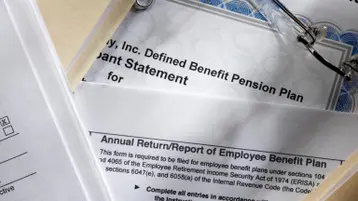Multiple Employer Retirement Plans: A Solution to SMB Employee Challenges

Table of contents
- 1.The importance of employee retirement plans
- 2.SMBs and employee retirement plans
- 3.Retirement benefits are good for business
- 4.Determining the best option for your employee retirement plans
- 5.The solution: a multiple employer 401(k) plan
Employee retirement plans are offered by an employer to help encourage their workforce to save for the future. There are several different options for employer retirement plans—401(k), 403(b), simple IRAs—but, on the most basic level, they tend to work in a similar way. If an employee enrolls in an employer’s retirement plan, their contributions come directly out of their paycheck. This automatic process is an easy way to help employees save for retirement. Contributions can be taken on a pre-tax basis or on a Roth after tax basis. While this sounds fairly straightforward, small to medium-size business (SMB) owners may be skeptical about offering employee retirement plans.
However, if you want to run a successful business where employees are engaged and productive, it’s important to create a well-rounded experience for your workforce. This includes offering an array of benefits, including retirement plans or tools to assist in planning. Specifically offering a retirement plan can help to incentivize employee retention and performance.
The importance of employee retirement plans
After the initial period of labor reduction during the onset of the pandemic, more workers and families shifted their focus to savings. According to a Fidelity Investments survey, 63% of respondents have been focusing on improving their investing habits in one way or another since the beginning of the pandemic.[1] In fact, many adults who utilize their company’s employee retirement plan would prefer to have a higher employee match contribution (57%) than more PTO (43%) and 81% would rather save for retirement as opposed to a wedding or other big life event.[2]
These statistics demonstrate the large shift in mindset happening in the workforce across the U.S. The focus is now on retirement planning and saving for the future. So, when a company offers benefits that are in line with these goals, they have the ability to attract top talent and grow their workforce in a way that aligns with long-term goals.
SMBs and employee retirement plans
Historically speaking, a lack of retirement benefits has been a particular problem for employees of smaller companies. This is especially true for SMBs with fewer than 50 employees. According to a recent survey, 74% of small businesses still don’t offer a retirement plan for their employees.[1] The main reasons behind this is that they feel their company is either too small or the 401(k) plans available are too expensive. However, many large organizations offer their workforce retirement benefits. This can create a talent acquisition and retention problem for SMBs. Instead, SMBs should focus on finding an employee retirement plan that aligns within their capabilities while still providing benefits to their workforce.
Retirement benefits are good for business
Employee retirement plans are an important part of a comprehensive benefits package, especially if you’re trying to maintain top talent and create a scalable infrastructure. With the societal shift of saving rather than spending, big companies that offer attractive 401(k) plans may have an advantage recruiting and retaining high-quality talent. Although it can be an investment, it’s important to look at the positives of employee retirement plans from a business standpoint.
First and foremost, offering a retirement plan gives your employees the chance to save for retirement effortlessly by using payroll deductions. This level of convenience is appreciated throughout the workforce as it increases the likelihood that employees will make an effort to save. The high contribution limits for 401(k)—$20,500 in 2022—make these retirement plans more attractive to serious savers. Employees age 50 or older can save an additional amount of $6,500 in 2022. The IRS can change these contribution limits annually, so it’s important to stay up to date with updates as they occur.
Just making these benefits available can help you attract and retain skilled employees. You don’t necessarily need to offer an employer contribution or matching but doing so will make the benefits much more attractive to your employees. If you have a very small company or are just getting started, you can implement your employee retirement plans without employer contributions and amend the policy later on.
SMB leaders may tend to avoid offering employee retirement plans because of cost and time. Business owners may not think they can afford the plan administration costs and don’t have the time or expertise to administer a 401(k) plan. Since the regulations can be complicated and demanding, and there are penalties associated with administering a plan incorrectly, thus, navigating the intricacies of administering an employee retirement plan is a valid concern. There are several different options for retirement services and providers that can assume these responsibilities for employees. This tends to make the benefits of retirement benefits outweigh the costs.
Determining the best option for your employee retirement plans
Although there are opportunities for assistance, choosing the best option isn’t always straightforward and trying to sort out the details of retirement planning can be overwhelming. There are hundreds of different providers available, each bringing unique advantages and disadvantages. However, choosing the right plan is one of the best ways to help support your ongoing success and improve overall employee experience. To get the assistance you need to navigate the details of various providers and plans, consider working with a professional employer organization (PEO). PEOs can help you manage your employee retirement plans while leveraging a multiple employer 401(k) plans. This offers SMBs a solution to the many challenges that an independent employee retirement plan can bring.
The solution: a multiple employer 401(k) plan
To reap the benefits of employee retirement plans without feeling like you’re overspending time and money, consider looking into multiple employer 401(k) plans (MEP). An MEP is a single plan that’s been adopted by a group of employers. A third party—such as a PEO—serves as the plan administrator.
Multiple employer 401(k) plans allow employers to offload most, if not all, of the plan administration. It can also help alleviate and navigate some of their fiduciary liability and helps business owners comply with the rules and regulations surrounding retirement benefits. Also, as a result of the economies-of-scale pricing, administrative costs associated with a MEP are often lower than what an employer would get if they were to sponsor their own plan.
MEPs aim to address many of the employer’s concerns about offering a retirement plan for their employees including both time and cost commitment. By sharing the cost with other employers, you gain access to attractive retirement benefits without having to make a large upfront investment. However, MEPs don’t completely take the accountability away from a business owner. It’s still the responsibility of each employer to perform separate, non-discrimination testing, which can be problematic for some employers. To help you with these challenges, consider partnering with a PEO.
One of the biggest benefits of working with a PEO is the attractive packages you gain access to without traditionally expensive fees. PEOs act as a third-party sponsor, which allows you to increase the likelihood that you remain compliant without spending hours on repetitive administrative tasks. With MEPs, PEO sponsors have some fiduciary liability and greatly reduce the overall burden placed on your internal team. The PEO maintains records and employee paperwork, determines employee eligibility, files federal annual reports, handles disclosures or investment information and makes sure that employee contributions are deposited accordingly. Outsourcing your employee retirement planning and other benefits can help improve risk mitigation strategies and give you more time to focus on advancing the goals of your business.
When you’re ready to partner with a PEO and gain access to HR experts who are committed to helping you save money on attractive 401(k) plans, TriNet can help. We offer MEPs to SMBs to help attract top talent, gain a competitive advantage and help boost employee retirement savings. Learn how TriNet’s comprehensive HR solutions can help your business today.
[1] Plan Sponsor, “Three in Four Small Business Don’t Offer a 401(k) Plan.”
[1] Fidelity Investments, “Reflecting on 2 Years of COVID.”
[2] Fidelity Investments, “Reassessing Financial Priorities After the Past Two Years of Uncertainty.”
TriNet Team
Table of contents
- 1.The importance of employee retirement plans
- 2.SMBs and employee retirement plans
- 3.Retirement benefits are good for business
- 4.Determining the best option for your employee retirement plans
- 5.The solution: a multiple employer 401(k) plan






